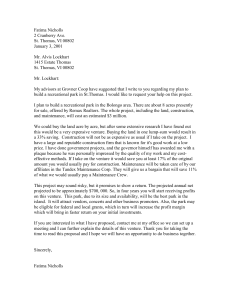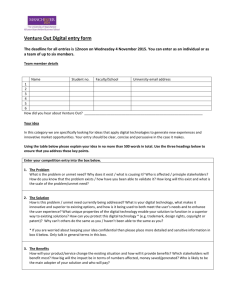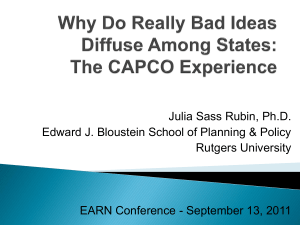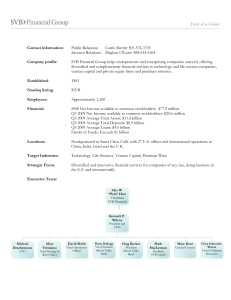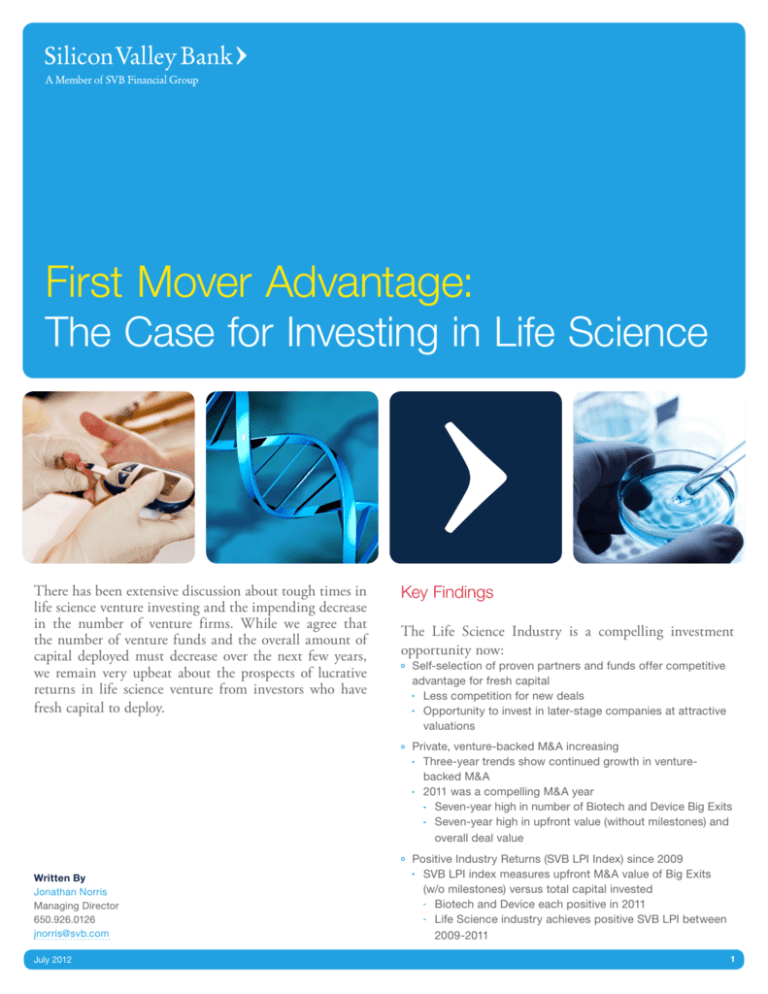
First Mover Advantage:
The Case for Investing in Life Science
There has been extensive discussion about tough times in
life science venture investing and the impending decrease
in the number of venture firms. While we agree that
the number of venture funds and the overall amount of
capital deployed must decrease over the next few years,
we remain very upbeat about the prospects of lucrative
returns in life science venture from investors who have
fresh capital to deploy.
Key Findings
The Life Science Industry is a compelling investment
opportunity now:
{{
Self-selection of proven partners and funds offer competitive
advantage for fresh capital
Less competition for new deals
Opportunity to invest in later-stage companies at attractive
valuations
•
•
{{
Private, venture-backed M&A increasing
Three-year trends show continued growth in venturebacked M&A
2011 was a compelling M&A year
Seven-year high in number of Biotech and Device Big Exits
Seven-year high in upfront value (without milestones) and
overall deal value
•
•
––
––
{{
Written By
Jonathan Norris
Managing Director
650.926.0126
jnorris@svb.com
July 2012
Positive Industry Returns (SVB LPI Index) since 2009
SVB LPI index measures upfront M&A value of Big Exits
(w/o milestones) versus total capital invested
Biotech and Device each positive in 2011
Life Science industry achieves positive SVB LPI between
2009-2011
•
––
––
1
In the last three years, we have observed significant value
creation in life science venture-backed M&A. In 2011,
both the number and total value of Big Exits (defined
as private, venture-backed exits with upfront of at least
$50M in Device and $75M in Biotech) reached sevenyear highs. We believe the life science venture industry is
in a position to continue this up-cycle. Those funds with
first-mover advantage — funds deploying fresh capital
now and over the next few years — are best suited to
exploit the upward swing. The time to invest is now, as
favorable trends have developed enough to demonstrate
the ability to achieve significant outsized returns. In this
paper we will explore the current trends that make the life
science sector an attractive place for investment.
Background: Disconnect between capital deployed
and raised will lead to a reduction in life science
venture investment
While many experts have commented on the downward
trend in life science investing, the amount of capital
invested into venture-backed life science companies has
actually been fairly constant between $6B and $8B since
20051. Life science investment as a percentage of all
venture investment has also been consistent, averaging
27% of all venture investment over the last five years1.
However, life science venture fundraising is at odds
with life science dollars invested, which has outpaced
fundraising in every year since 2007 (Exhibit 1).
The chart below includes all venture life science funds by
vintage year, as well as all multi-focused funds’ allotment
to life science per our best educated guess.
Exhibit 1: Life Science Venture Funding Gap
Year
Total LS Venture $ Deployed ($M) Gap in Funding
LS $ Invested
LS $ Fundraised
2005
5,991
5,787
2006
7,287
11,176
65%
2007
9,098
8,031
113%
2008
8,041
5,973
135%
2009
6,297
3,440
183%
2010
6,213
1,837
338%
2,437
309%
2011
7,539
Source: SVB proprietary information and Thompson Reuters
1
% Overfunded
PricewaterhouseCoopers MoneyTree data, 2005-2011.
July 2012
104%
In total, since 2005, there has been a 25% gap in life
science venture dollars raised versus life science venture
dollars invested. For the last two years (2010-2011) the ratio
has been more than 3:1 in dollars deployed versus dollars
raised. Even with corporate venture and non-venture
equity funding filling some of the gap, the current trend of
$6B+ per year invested into life science companies cannot
continue. The last $6B+ fundraising year was 2007 — and
that vintage year is at or near the end of its active new
investment cycle — and close to fully invested. Since 2009,
fundraising averages only $2.6B raised per year. That
trend will continue, and we believe going forward that life
science funds will raise between $2.5B to $3.5B per year.
A smaller percentage of high performing funds will be able
to fundraise; many of them at smaller dollar amounts than
previous funds. With less capital to invest in the market,
life science dollars deployed will also come down, likely
reduced to the $4-5B range.
These downward trends enable firms that have fresh capital
to invest to achieve significant returns in this sector. In the
following section we will detail the trends that position life
science venture as an attractive investment area.
Why Life Science is an attractive place to
deploy capital (both for VCs and LPs)!
1) Self-selection of proven funds (or investors)
Fundraising in the life science sector is difficult. In order
to attract attention and LP dollars, venture funds need
to show substantial distributions back to LPs. In this
investment cycle, distributions that garner LP interest
and their commitments for the next fund are typically
shown in two different ways: 1) a very high distribution
to paid in capital (DPI) percentage in a firm’s most recent
fund (busting through the J-curve), or 2) substantial
distributions across multiple funds demonstrating that
the investment thesis over time is now yielding results.
Either way, the funds that will be successful raising
money in this environment will need to show a solid track
record for achieving exits and distributing money back to
investors. As these firms raise their next funds and others
do not, the new subset of active life science venture funds
will be high-quality proven exit makers. These investors
will form highly competent syndicates that know how to
create value in this environment and form companies that
will compete against a smaller number of venture-backed
competitors in their space.
2
Our Big Exit data supports that notion of a concentrated
group of life science venture firms responsible for an
outsized portion of Big Exits. If we examine the 170 Big
Exits in Biotech and Device since 2005, the top 10 life
science venture funds measured by number of Big Exits
were responsible for 52% of all big exits since 2005. If
we expand that to the top 20 life science venture firms,
that number increases to a 66% share of all life science
Big Exits. This analysis accounts for any double dipping
(if more than one top firm is involved in the exit, it only
gets counted once). If we count every Big Exit for the top
10, these firms generate 128 exits — almost 13 Big Exits
per firm. The takeaway here is that already a smaller
subset of firms account for the vast majority of life science
Big Exits. These are the firms that will be able to show
enough exit activity to support raising their next fund.
2) Quality new deals, attractive existing deal flow
With a smaller set of solid, Big Exit-minded firms with newly
committed capital, the number of companies funded will
go down but the quality should go up. While the number
of companies receiving Series A investment ($500,000+
investment size is our criteria) has held relatively stable over
the last two years (Exhibit 2a), our prediction is that we
will likely see a 15-25% drop in the number of companies
receiving their first round of equity investment over the
next few years and through this current cycle.
Exhibit 2a: Biotech Series A Data
6,000
Dollars Raised ($M)
# of Companies
120
5,000
100
4,000
80
3,000
60
2,000
40
1,000
20
0
2005
2006
2007
Total Biotech Dollars
Raised
2008
2009
Biotech Series A
Raised
2010
2011
# of Series A Funded
Companies
First Mover Advantage: The Case for Investing in Life Science
0
Exhibit 2b: Device Series A
6, 000
Dollars Raised ($M)
# of Companies
100
90
5, 000
80
70
4, 000
60
50
3, 000
40
2, 000
30
20
1, 000
0
10
0
2005
2006
Total Device Dollars
Raised
2007
2008
Series A Dollars
Raised
2009
2010
2011
# of Series A Funded
Companies
Source: SVB proprietary information, PWC MoneyTree and VentureSource
The number of these newly funded companies will
decline based on less capital available to deploy. However,
valuations in these companies will be attractive for
investors, as limited access to capital enables investors
with fresh capital to be in an advantageous position to
negotiate equity valuations. In addition to creating new
companies, the firms with this fresh capital have first look
at the abundance of later-stage, VC-backed companies
that have achieved technical goals but still need venture
funding. There are more than a thousand life science
companies that have been created since 2000 that are
still private and likely need additional equity. Many of
these companies have existing syndicates that are unable
to support the company with additional equity to get to
the next value inflection milestone. This presents a great
opportunity for new, deep-pocketed capital to come in at
attractive valuations. The subset of these older companies
that attract fresh capital will move forward with advanced
development and stand an increased chance of achieving
quicker, high-multiple exits for the last round investors.
3) Compelling increase in overall exits
2011 was a great year for the number of biotech and
device Big Exits (35) and total deal value ($12.7B). (See
our article “Continued Rebound: Trends in Life Science
M&A”). The number of Big Exits (Exhibit 3a) and Big
Exit deal value with and without milestones (Exhibit
3b) have continued the trend upwards between 2009
and 2011, with 2011 achieving the highest value in both
categories since SVB started tracking this data in 2005.
The three-year trendline shows increased exit activity and
deal value. Specifically in Biotech, the looming patent
cliff, large cash reserves, and declining internal R&D of
3
acquirers supports the idea of building pipeline value from
both early and later-stage, venture-backed companies.
Life Science Industry Returns – Introduction to SVB LPI Index
Acknowledging that we live in a sector where we are
investing much more than we raise, a simple question
emerges: is the industry receiving value back from capital
invested? We analyzed life science sector performance
using a simple cash in/cash out liquidity to invested
capital analysis.
Exhibit 3a: M&A Big Exits per Year
20
18
16
# of Big Exits
14
12
10
8
6
4
2
0
2005
2006
2007
2008
2009
2010
2011
Med Device
Biotech
14,000
35
12,000
30
10,000
25
8,000
20
6,000
15
4,000
10
2,000
5
# of Exits
Exit Volume ($M)
Exhibit 3b: Total Big Exit $ Volume
0
0
2005
Upfront
2006
2007
2008
Upfront w/ Milestones
2009
2010
2011
# of Exits
Source: SVB proprietary information, press releases
Since the transition to the structured deal-era in 2009,
overall biotech Big Exit deal values have actually increased.
In 2011, average upfront deals excluding milestones were
$320M and average total deal value, including milestones,
was $519M. 2011 was also had the biggest number of
biotech Big Exits, at 17. In Device, the average upfront
deal value in 2011 was $198M, which compares very
favorably to device total deal values from 2005 to 2008,
but the number of device Big Exits in 2011 (18) dwarfs
the average number of exits per year (10) achieved
between 2005 and 2008. Trends in number and dollar
volume continue to move up and to the right.
July 2012
4) SVB Life Science LPI Index points to positive
industry returns since 2009
We created the SVB LPI Index to track life science
venture performance year over year (Exhibit 17). LPI
is defined as liquidity to paid-in capital invested. The
numerator (the liquidity part of the equation) tracks Big
Exit upfront value. We do not include any milestones
to be earned and also do not include any public market
exits that provide returns to LS venture funds. We did
not include milestones to be earned in order to provide
a true measure of value returned at the close of the
transaction — the “bird in the hand” analysis. While
the IPO market and public market M&A are important
sources of returns for investors, especially more recently
on the biotech side, it is difficult to measure performance.
We would rather understate the liquidity generated than
overstate returns. The Big Exit liquidity number is a
good indicator of private M&A value created, albeit a
lower number than actual liquidity earned by life science
funds. The denominator (the paid-in capital invested part
of the equation) measures the amount of venture dollars
invested into device and biotech companies per year.
The SVB LPI Index is merely an indicator of the health
of the life science venture industry. In this overfunded
sector, many who know Life Science would guess that the
industry is investing substantially more into companies
than it is receiving back in real exit value. The results in
2011 and over the last three years are surprising.
4
Substantial Positive SVB LPI Index in 2011, and positive for
the industry between 2009-2011
Even with the understated “liquidity” numerator and the
overfunded “paid-in capital” denominator, the SVB LPI
provides positive results. In 2011, the third highest year in
life science venture investment since 2005, the SVB LPI
was positive in both Device and Biotech, each clocking
in with returns above 1.15X. This means that upfront
Big Exit M&A value received (not including any to be
earned milestones) was more than the substantial capital
invested last year. The hot exit environment referenced
earlier in this paper is the reason for this positive SVB
LPI, and points to a very viable upward trendline. Even
more surprising, Device has a positive SVB LPI every
year since 2009, with a very solid three-year SVB LPI of
1.44X. In a very difficult regulatory environment, and
despite the perception of device investing as “challenged”,
returns back from venture-backed device companies are
consistently beating capital invested.
Over the last three years, the SVB LPI for the entire
venture life science industry is positive at 1.08X! If we
include to-be-earned milestones the LPI grows to 1.7X.
Strong results from the last three years do not substantially
change the overall 10-year life science return data, but it
does provide validation that the industry is achieving
positive results. Investors looking at the 1.08X might not
be impressed, but it is the trendline that is important
here. For example, in 2005 Device provided just over
$1B in upfront Big Exit returns. Between 2005 and
2008 that number fluctuated from $1-2B per year. Since
2009, upfront Big Exit returns have grown significantly,
achieving over $3B each year. Last year, Biotech reached
its highest value returned since we started tracking this
data, at over $5.4B. This is a trendline to watch. Overall,
2011 was a banner year for venture created liquidity, with
$8.8B in value created just in upfront Big Exit values.
Those who say there is no liquidity generated in venture
life science are clearly mistaken.
Exhibit 4: SVB LPI by Sector
Device
Biotech
$ invested ($M)
$ Exited Upfront
($M)
LPI
$ invested ($M)
$ Exited Upfront
($M)
LPI
2005
2,210
1,041
47%
3,781
2,668
71%
2006
2,816
2,015
72%
4,471
3,044
68%
2007
3,715
2,133
57%
5,383
4,948
92%
2008
3,458
1,281
37%
4,586
1,880
41%
2009
2,575
3,468
135%
3,722
2,891
78%
2010
2,347
4,173
178%
3,866
2,249
58%
2011
2,806
3,365
120%
4,733
5,447
115%
Year
SVB LS Industry LPI
Year
$ Invested ($M)
$ Exited Upfront
($M)
Yearly LPI
2009
6,297
6,359
101%
2010
6,213
6,422
103%
2011
7,539
8,812
117%
= 1.08 X LPI
Source: Press Releases, SVB proprietary information and PWC MoneyTree
First Mover Advantage: The Case for Investing in Life Science
5
However, a positive SVB LPI does not point to a vibrant,
healthy life science venture industry as a whole. Combined
with the data above showing that the majority of Big
Exits cluster among a small group of funds, it points to a
subsection of funds that are receiving an outsized portion
of these distributions. These are the very funds, as we
discussed earlier in the paper, which will be able to raise
their next fund.
Summary: Good time to invest in Life Science
Indicators point to an increasingly attractive investment
environment for investors with capital, as there will be
less competition for funding great technologies. Less
overall capital in the market translates to attractive
valuations for investors. Big acquirers will continue to
buy more, not less, at attractive valuations. We believe
the SVB Life Science LPI will continue to be positive as
capital deployed decreases and M&A appetite continues
to be robust — especially in Biotech where poor R&D
efficiency and patent cliffs will remain significant drivers
for big pharma to keep acquiring. This should continue
the trend of robust returns in the life science sector. Life
science venture firms that recently closed a new fund or
are able to fundraise in the next 12 months will be in
prime position to reap these rewards. The first mover
advantage has arrived — the time to invest is now.
July 2012
6
Silicon Valley Bank Headquarters
3003 Tasman Drive Santa Clara, California 95054, U.S.A.
Phone 408.654.7400 svb.com
©2012 SVB Financial Group. All rights reserved. Member Federal Reserve System. SVB>, SVB>Find a way, SVB Financial Group, and Silicon Valley Bank
are registered trademarks. B-12-12265. Rev. 07-18-12.



